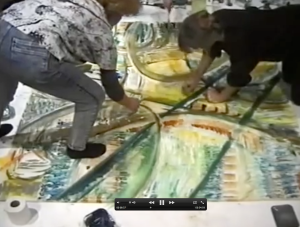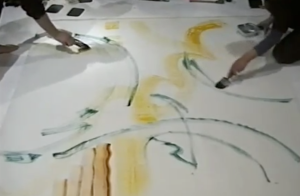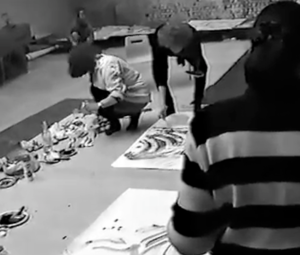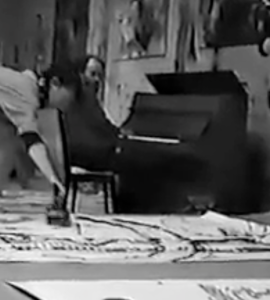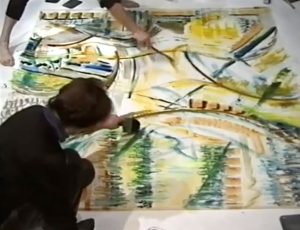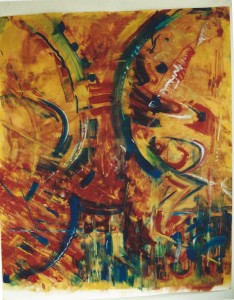This process originated indirectly from the Surrealists. Two of us, Sylvie Le Seac’h and myself were participating in the ‘Cadavre Exquis’, a method of writing very disjointed poetry – only the last letter of a word being exposed to the person continuing from there – hence the title ‘Cadavre Exquis’. In a visual way, the last section of a line (or point) remaining while the rest was hidden, the follower continuing from this point or fragment of line. We tried this with the expected inconsistent results. However, going further (this was part of our own discovery) we tried to see what would result if we permitted our drawing to interpenetrate – and found this exiting – the drawings retaining their original character but infiltrating or modifying each other. Encouraged by this, several artists began to paint together, their lines interlapping to form a new structure.
Why is this work done horizontally on the floor? This is another application of this Surrealist technique called Automatic Drawing or Unconscious Drawing, (adopted and adapted by the etcher, S.W. Hayter). With the Surrealists, themselves, it consisted merely in relaxing completely and letting the hand draw but there were other necessary conditions. It might seem the most simple thing in the world to relax and let the hand draw freely but if there is any tension in the hand or in the arm, any opposition, the hand is constrained, and instead of drawing automatically it repeats, tries to create interesting forms. The hand should be so independent, even unattached, that pushing against it, ones find no opposition. Beside this, the velocity should be constantly varied so that there is no imposition of the same speed – sometimes the hand must proceed slowly, sometimes stop or continue rapidly. This, too, was integrated into our working even beyond the gestural stage, including periods of intense painting and still observation before renewed activity. We extended the idea of the freely moving hand to the freely sweeping arm, indeed the whole body should participate. Hence, we draw upon the floor where the arm can glide without impediment.
Several of us had been working at the Atelier of S.W. Hayter in Paris, not, of course, on the same canvas or same plate, but at different times in the same Atelier so we shared certain presuppositions – everything on the plate or canvas, must be relevant, through visual counterpoint to everything else – each gesture transforms those which had gone before and is relevant to those which follow. Therefore, we employ a number of translucent or transparent colours so the layers can be seen through each other, transforming each other so obviously or rather obscurely. Someone who would use heavy, obliterating paint would have to be accommodated in another way – perhaps through « unconscious counterpoint » or another strategy would be necessitated.
We begin by collectively consciously choosing the colours – three colours which impose a limitation which can be powerful. The colours resulting from interwoven gestures with a brushful of single-hued paint can lead to dark but brilliant, new undefinable colours. We paint on paper of one meter and a half or on canvas with a great variety of media – oil paints, acrylic, ink, crayons, oil bars, reflecting paper and collage, metallic paints – simultaneously or successively. (For instance it is exciting if non-orthodox to apply ink or acrylic over oil paint which repels it forcing the contraction into non-thought-of shapes while maintaining the overall form.)
For the exhibition we had in Paris at ‘La Fonderie’ in Montreuil under the auspices of the publisher, John Calder we concentrated the ideas permeating the group to form a « Manifesto » which will be elucidated here.
« We end the fear of the Unconscious creativity of others and replace it with a dialogue Between different unconsciousness »
We mean by ‘the unconscious’ not the Freudian unconscious which would lead us back to scrutinise our early childhood traumas, and which if interposed would create opacity – imagine a Lucien Freud superimposed on Francis Bacon – but instead a more forward looking, leading toward the future, through integration. This is more Jungian.
« Let us bring to amend the arbitrary in art in favour of the rigorous and mysterious structure of the unconscious ».
The collective Jungian unconscious possesses a latent logic which develops according to its own intuitive but powerful rules. Take an example: a given presented space is not empty but contains directions in which the eye moves freely and other directions which hinder such movement. The space is, in fact, asymmetrical, limiting and accelerating the eyes fluent movement, thus.
Such limitations and powers of the field as a whole yield intuitive directions which govern the co-operation – and out of these a unity may arise.
«There is a whole unconscious structure that must be explored without fearing the dialogue of an unconscious which is different from our own.»
One finds that although each person at the beginning has a characteristic line, as one progresses – sometimes imitating or modifying each others lines, a unity arises within the confines of a given space.
« The question is here how to explore those structures of the unconscious that can enable work to take place simultaneously or sequentially in the same space, developing in visual terms a form of counterpoint».
Counterpoint is, of course, a term of music referring to a melody added as an accompaniment to a given melody always with a certain but varying degree of relevance to it. It is within the bounds of this relevance that variation can take place. Similarly in visual terms: given a curve one might react in different ways – from simply copying it another part of the painting to reversing it, twisting inside out to doing something completely dissimilar but having still some reference to that original curve.
«Put in another way, a linkage is established between what one person has just done and what another is about to do ».
A process of natural growth guides the participants.
« Communal work very quickly eliminates the personal unconscious and allows it to become the collective unconscious».
Although actually reaching the collective unconscious might seem the ultimate, a sort of Samadhi, we can be propelled toward it gradually. We might begin to concentrate on the same spot thinking « There something must take place » or to exchange paint-laden brushes, involved in another persons unconscious gesture. We are propelled by what might be seen as a sort of telepathy.
Then we emerge from this telepathic state to consider the configuration and in what directions it can go to insure the maximum of integration with the most underlying complexity. We begin to talk.
« In practice, in order for there to be a dialogue between structures of these different unconsciousnesses and the conscious, each one has to be highly aware of what the others are doing, as in a chess game where the desire to be competitive is excluded ».
As in chess, one must look at the whole field, to be aware of everything that has changed and how it might change. In this way our game is similar to chess where one must be aware of the whole region in its transformations or potential transformations but with the desire to contribute to its completion rather than a desire to halt its progress “by checking” it.
The desire for competition should yield to the desire for co-operation in contributing to the unity of the painting.
« Each one must feel a need to observe all of the possible paths that can lead to a progressive establishment to a certain coherence. It is no longer a question of who has done what but of concentrating instead on what has already been committed by the others to the paper» and subtly working with others to bring it into some kind of underlying integration while maintaining the maximum of diversity.
« At first different types of coherence appear and can be metamorphosed during the course of the work. This, in practice, takes the form of a process coming into being that, as it approaches its completion, provokes an analysis, a reconsideration and a collective decision».
What was begun as a descent into the unconscious becomes a conscious decision. One thinks the work might progress in this way or in that. One stands back and judges and discusses. One begins to talk prior to making a collective resolution.
« In this way a certain kind of unconscious meaning can lead through conscious discussion to unity».
Or it might be necessary to re-immerse oneself into the unconscious in order to find new connections, those which will bring about a total integration. Either a collective decision might determine that path to be chosen or this sought-for unity might appear spontaneously in some anticipated way and bring about a feeling of harmony or it might not. There is always a danger until the final result appears.
«To sum up, collective creation has to do with spontaneity that comes from the unconscious which is succeeded by a common critical attitude».
There is thus an interaction of the unconscious followed by and modified by the conscious in which the field of choice can be limited or extended.
« What would be the point of several people working together if it where not to understand that an intuitive creative growth can exist which arises from the unexplored structures of the unconscious modified by a conscious collective decision».
Such a resultant painting might be extremely different from the ways in which the collaborative artists work individually.
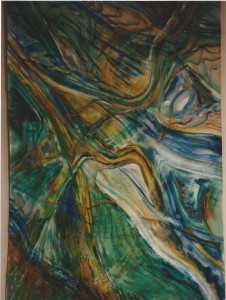 In all of our successful paintings the end result looks as if it has been painted by a single person. Although at the beginning we work together in a relaxed manner, as the painting nears its conclusion there is danger, conscious danger, as we pursue mentally the different options. At this point there is a risk, the danger of losing this almost integrated whole into incoherence.
In all of our successful paintings the end result looks as if it has been painted by a single person. Although at the beginning we work together in a relaxed manner, as the painting nears its conclusion there is danger, conscious danger, as we pursue mentally the different options. At this point there is a risk, the danger of losing this almost integrated whole into incoherence.
« During the course of history there have been a number of precedents ».
The Surrealists engaged in communal work in an experience they referred to as « Cadavre Exquis » which was a form of composing highly incoherent poetry or visual work by exposing to the following person only the last letter or the point of the line and continued inconsistently from there has already been discussed. From this coherence was, of course, missing. During his Braque-influenced period, Picasso worked together with Braque but we can look, in vain, to find how they complimented each other. The COBRA group – Copenhagen, Oslo, Brussels and Amsterdam – painters such as Apple, Jorn, Corneille and others worked together but there too the differences were not so clear as their similarities.
While these group of painters lacked either coherence or diversity, in a successful painting we combine them both.
The name of the group, ‘Collective Phenomena’, had been chosen because it refers to both the way in which artists collaborate but also has wider resonances in those collective phenomena of a social or even scientific nature.
To start with the simplest case: a single molecule would follow the laws of motion which govern its movement – action equals reaction – but once the concept of temperature and pressure have been introduced – concepts which are inapplicable to a single molecule but only to a collective of particles – it is subjected to restrictions of an intricate nature resulting in the ‘Gas Laws’. At a higher level of complexity, when atomic forces of attraction and repulsion operate – the coherence is yet more involved, extending through the inorganic to biological beings – even to the brain itself.
As artists, being intense individuals, we begin each having his own particular type of line or colour areas, but once they are intertwined, in accordance with visual counterpoint, a new network arises, a new unexpected intricacy or simplicity may be born. Our title locates us in a larger context (Could we serve as a collaborative model for social institutions?) and even among atoms, molecules and organic life – at all levels of complication.
Paul Klee says poetically in his book, ‘Concerning Modern Art’:
«What artists would not like to live where the central organ of all space-time motion – call it brain or heart of creation as you will – activates all functions: in the womb of nature, in the primal ground of creation where the secret of all things lie hidden? »
We, together, act in accordance with laws which we cannot precisely formulate, but only approach and assimilate, following in an intuitive way in accordance with instinctive pressure of visible counterpoint and the field structure of space in a dialectic between the conscious and the collective unconscious.
Liverpool 1996

